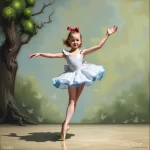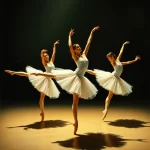Ballet: Alice’s Adventures in Wonderland (Joby Talbot, 2011)

Introduction
Ballet: Alice’s Adventures in Wonderland is a captivating and whimsical ballet adaptation of Lewis Carroll’s beloved novel. Choreographed by Christopher Wheeldon and composed by Joby Talbot, this ballet premiered on February 28, 2011, at the Royal Opera House in London. The production brings to life the fantastical world of Wonderland, following Alice’s journey through a series of surreal and enchanting encounters.
Historical Background
Creation and Development
The creation of Alice’s Adventures in Wonderland ballet was influenced by a rich tapestry of historical, social, and artistic elements. The early 21st century saw a resurgence of interest in reimagining classic literature through various art forms, including ballet. The inspiration for this ballet came directly from Lewis Carroll’s 1865 novel, which has been a cornerstone of children’s literature and a source of fascination for readers of all ages.
Christopher Wheeldon, a renowned choreographer, collaborated closely with composer Joby Talbot to bring this vision to life. Their partnership was marked by a shared commitment to creating a ballet that was both faithful to the original story and innovative in its artistic expression. The production also involved key figures such as designer Bob Crowley, who contributed to the visual splendor of the ballet.
Premiere and Reception
The ballet premiered on February 28, 2011, at the Royal Opera House in London. The initial reception was overwhelmingly positive, with critics and audiences praising the production’s creativity, visual appeal, and the seamless integration of dance and music. Notable early performances included revivals at the Royal Ballet and international tours, which further solidified the ballet’s reputation as a modern classic.
Synopsis of the Ballet
Act I Summary
The ballet opens with a garden party at the home of Alice and her family. Alice encounters Lewis Carroll, who transforms into the White Rabbit. As Alice follows the White Rabbit down the rabbit hole, she finds herself in the fantastical world of Wonderland. Key characters introduced in this act include the Queen of Hearts, the Mad Hatter, and the Cheshire Cat. The act concludes with Alice shrinking and growing in size, setting the stage for her adventures to come.
Act II Summary
In Act II, Alice navigates through Wonderland, encountering a series of bizarre and whimsical characters. She attends the Mad Hatter’s tea party, meets the Caterpillar, and witnesses the Queen of Hearts’ croquet game. Major turning points include Alice’s growing realization of her own identity and her determination to find her way home. The act is filled with vibrant dance numbers and imaginative set pieces that capture the essence of Carroll’s world.
Finale
The ballet’s finale sees Alice confronting the Queen of Hearts in a dramatic courtroom scene. As tensions rise, Alice’s courage and wit help her navigate the chaos. Ultimately, she awakens from her dream, back in the garden with her family. The conclusion underscores the themes of self-discovery and the power of imagination, leaving the audience with a sense of wonder and enchantment.
Musical Composition
Composer’s Role
Joby Talbot, a versatile and accomplished composer, played a crucial role in shaping the musical landscape of Alice’s Adventures in Wonderland. His score is characterized by its eclectic blend of classical and contemporary elements, creating a soundscape that is both whimsical and emotionally resonant. Notable pieces within the score include the “Mad Hatter’s Tea Party” and the “Queen of Hearts’ Croquet Game,” which highlight Talbot’s ability to capture the essence of Carroll’s characters and scenes.
Musical Themes and Motifs
The score features recurring musical themes and leitmotifs that enhance the narrative and emotional depth of the ballet. For instance, the White Rabbit’s theme is playful and hurried, reflecting his anxious nature, while the Queen of Hearts’ motif is grandiose and menacing. These musical elements help to underscore the characters’ personalities and the shifting moods of the story, drawing the audience deeper into the world of Wonderland.
Famous Recordings and Performances
Several recordings of the ballet’s music have been released, capturing the brilliance of Talbot’s composition. Notable performances include those by the Royal Ballet, which have been widely acclaimed for their musical and choreographic excellence. These recordings serve as a testament to the enduring appeal of the ballet’s score and its impact on audiences worldwide.
Choreography and Dance
Choreographer’s Vision
Christopher Wheeldon’s vision for Alice’s Adventures in Wonderland was to create a ballet that was both visually stunning and deeply engaging. His choreography is characterized by its fluidity, inventiveness, and attention to detail. Wheeldon introduced several innovations, such as the use of multimedia elements and intricate set designs, to enhance the storytelling and create a truly immersive experience.
Signature Dance Numbers
Key dance numbers in the ballet include the “Mad Hatter’s Tea Party,” a lively and eccentric ensemble piece, and the “Pas de Deux” between Alice and the Knave of Hearts, which is both tender and dynamic. These dances not only showcase the technical prowess of the performers but also reflect the characters’ emotions and relationships, adding depth to the narrative.
Notable Interpretations
Over the years, different productions have brought their own interpretations to the choreography of Alice’s Adventures in Wonderland. Some have emphasized the whimsical and fantastical elements, while others have focused on the emotional journey of Alice. These variations highlight the versatility of Wheeldon’s choreography and its ability to resonate with diverse audiences.
Characters and Roles
Main Characters
- Alice: The protagonist, a curious and adventurous young girl who embarks on a journey through Wonderland.
- White Rabbit: A nervous and hurried character who leads Alice into Wonderland.
- Queen of Hearts: The tyrannical ruler of Wonderland, known for her volatile temper and love of croquet.
- Mad Hatter: An eccentric and whimsical character who hosts a chaotic tea party.
Supporting Characters
- Cheshire Cat: A mischievous and enigmatic character who appears and disappears at will.
- Caterpillar: A wise and philosophical character who offers Alice guidance.
- Knave of Hearts: A charming and loyal character who becomes Alice’s ally.
Famous Dancers
Notable dancers who have portrayed these roles include Lauren Cuthbertson as Alice, Edward Watson as the White Rabbit, and Zenaida Yanowsky as the Queen of Hearts. Their performances have been widely praised for their technical skill and emotional depth, contributing to the ballet’s success.
Cultural and Artistic Impact
Influence on Ballet and Dance
Alice’s Adventures in Wonderland has had a significant impact on the world of ballet and dance. Its innovative choreography and imaginative storytelling have inspired other choreographers to explore new ways of integrating narrative and movement. The ballet has also contributed to the development of contemporary ballet, blending classical techniques with modern elements.
Cultural Significance
The ballet’s cultural significance extends beyond the world of dance. It has become a beloved adaptation of Carroll’s novel, celebrated for its creativity and artistic excellence. The production has also influenced other media, including film and theater, inspiring new interpretations of the Wonderland story.
Legacy and Revivals
Alice’s Adventures in Wonderland continues to be performed and celebrated today, with major revivals and reinterpretations keeping the ballet fresh and relevant. Its enduring popularity is a testament to its artistic merit and its ability to captivate audiences of all ages.
Iconic Productions
Historic Productions
The original production at the Royal Opera House in 2011 remains one of the most iconic in the ballet’s history. Key figures involved in this production included Christopher Wheeldon as choreographer, Joby Talbot as composer, and Bob Crowley as designer. Their collaboration set a high standard for future productions.
Contemporary Productions
Recent productions have continued to explore new dimensions of the ballet, incorporating advanced technology and innovative design elements. These contemporary interpretations have brought fresh perspectives to the story while maintaining the core elements that make the ballet so enchanting.
Production Design
The set, costume, and lighting design in various productions of Alice’s Adventures in Wonderland have played a crucial role in bringing the fantastical world of Wonderland to life. Bob Crowley’s designs, in particular, have been praised for their creativity and attention to detail, enhancing the overall visual impact of the ballet.
Critical Reception and Reviews
Initial Critical Response
The initial critical response to the ballet was overwhelmingly positive. Critics praised the production for its imaginative choreography, captivating music, and stunning visual design. The ballet was hailed as a modern classic, with many noting its potential to become a staple of the ballet repertoire.
Modern Reviews
Contemporary critics and audiences continue to hold Alice’s Adventures in Wonderland in high regard. The ballet is celebrated for its ability to appeal to both children and adults, offering a rich and multifaceted experience. Its relevance and popularity today are a testament to its enduring charm and artistic excellence.
Fun Facts and Trivia
Behind-the-Scenes Stories
One interesting behind-the-scenes story involves the creation of the Cheshire Cat. The character is brought to life through a combination of puppetry and dance, requiring intricate coordination between the performers. This innovative approach has become one of the ballet’s most memorable features.
Notable Performers
Famous dancers associated with the ballet include Lauren Cuthbertson, Edward Watson, and Zenaida Yanowsky. Their performances have been instrumental in defining the characters and bringing the story to life.
Trivia
- The ballet features over 60 different characters, each with unique costumes and choreography.
- Joby Talbot’s score includes a variety of musical styles, from classical to jazz, reflecting the eclectic nature of Wonderland.
- The production’s set design includes a giant rotating chessboard, adding to the visual spectacle of the ballet.
Conclusion
Summary of the Ballet’s Importance
Alice’s Adventures in Wonderland is a significant work in the world of ballet, celebrated for its innovative choreography, captivating music, and imaginative storytelling. It has made a lasting impact on the art form, inspiring new generations of dancers and choreographers.
Final Thoughts
The ballet offers a unique and enchanting experience, blending the timeless charm of Lewis Carroll’s story with the artistry of dance and music. Whether you are a seasoned ballet enthusiast or a newcomer to the art form, Alice’s Adventures in Wonderland is a must-see production that promises to delight and inspire.
FAQ
What is the central theme of this ballet?
The central theme of the ballet is self-discovery and the power of imagination, as Alice navigates the fantastical world of Wonderland and learns about herself along the way.
Who are the main characters in this ballet?
The main characters include Alice, the White Rabbit, the Queen of Hearts, and the Mad Hatter.
What is the most famous dance number in this ballet?
One of the most famous dance numbers is the “Mad Hatter’s Tea Party,” known for its lively and eccentric choreography.
How long does a typical performance of this ballet last?
A typical performance of Alice’s Adventures in Wonderland lasts approximately two hours, including intermissions.
Are there any modern adaptations of this ballet?
Yes, there have been several modern adaptations and revivals of the ballet, incorporating new design elements and technological innovations.
Why is this ballet considered important in the history of dance?
The ballet is considered important for its innovative choreography, imaginative storytelling, and its ability to appeal to audiences of all ages. It has set a new standard for contemporary ballet productions.





